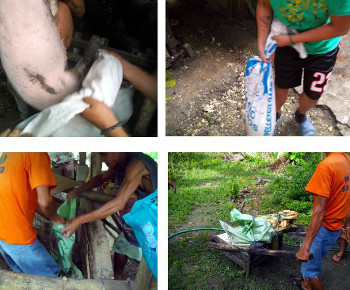

January February
Notes on 2017:
A year dominated by construction it seems:
Starting with a new roof on the house (March), then a rebuilding of the external kitchen (May), followed by a new pig pen (June), then two new pig pens (September) and a rebuilding of one of the the old ones (October).... plus the demolition of the goat pens and the building of a wall (October/November) along our boundary -after a dispute with a (non-resident) neighbour who could smell pigs when nobody else could.
So the intended "Conslidation" was mostly in the form of construction work, its aftermath and the distraction of clearing up after construction workers had finished constructing (and destructing)....
There was also hardship with both the Leyte Earthquake and a nasty storm in July.
A disasterous farrowing in August -but good ones in June and December.
After crushing several of her litter in January we decided that sow No. One needed to be culled.
Plants:
There is now a greater integration between animals and garden. Hedge and tree trimmings go to the goats, Fallen coconuts and Coconut branches also weeds go to the pigs. We are also starting to multiply forage trees and grow new ones i f possible.
In October (as the building programmes were ending) I realized that the garden was beginning to reach the point (or maybe had already long reached it) where trimming and harvesting were an important part of maintenance. I also realised that "harvesting" was part of "trimming"..... So the relationship between the plants and the animals becomes much closer......
These are intuitive things that can only come out of the work itself (if one is open to them). Fatima had already remarked that most of her farming friends (on Facebook) agree that one cannot put ones farm in the hands of other people..... One has to do it oneself..... and (in my experience) only through doing it oneself, and noticing the effects (and the problems) does one get the required understanding of how things work (slowly over time).
This is also why I object to NGO's who promote things -without the experience of having practiced them for a long time.....
The following changes seem to be successful:
- Planting season now starting in May, after the dry season has ended
- Less emphasis on trying to get things to grow -and more temphasis on maintenance and harvesting....
- More emphasis on plant care, in an attempt to increase production for animals and humans, as well as propagation
- Sorting plants by size more effectively to prevent choking of small plants by larger ones -although a mixture still seems desirable
However, more work needs to be done regarding:
- Planting beans in ways that allow them to climb, without too much excess growth.
- Protection of seeds and young sedlings from Chickens and ducks (perhaps including planting seeds amongst weeds to give protection from chickens)
- Use of "wild" areas for hardy plants such as beans, Saluyot, etc...
No advances with Hydroponics this year (bamboo rafts -or even edible water plants) -although we are building rain gardens to deal with excess water and we also have built an extra reservoir by the new pig pens.
We do hope to expand the range of water plants (and maybe fish) -but until now, they only seem sustainable in the reservoir by the house. However, this can perhaps function as a nursery for spreading to other water areas (duck and fish ponds).
Certainly, drainage channels and rain gardens are improving drainage -but perhaps more work is still needed on the paths. Obviously, the more ground cover there is, the better is the drainage, with less run-off and erosion from empty areas.
Growing small seeds (radish, greens, tomatos, eggplants, etc.) is still proving very difficult -although larger crops (sesame, beans, saluyot, etc.) did grow rather wild and out of hand at times -perhaps due to the distractions provided by the builders.
Animals:
Pigs:
Auntie Brownie farrowed successfully twice this year (in June and December).
Unfortunately, No.Three lost her entire litter in August due to Porcine Parvo Virus. However she is pregnant again -and we hope that she is now immune.
No.One has been culled, after crushing several piglets in January.
We have also reduced the group down to just Auntie Brownie, No.Three and Boar Pinkie'. However, each pig now has its own (newly built) pen.
We also have a spare pen for fattening one or more of the piglets (usually the runt) for our own consumption. The other piglets get sold off.
Hopefully, in future, we can manage two farrowing in a year from each of our two sows.
Goats:
Snowball has been sold off -but we still have Latte and the two kids (born in February).
We are planning to get sell the two kids and get a new female for Latte.
Ducks:
The duck population has also been severely reduced -with ten (now fairly large) ducklings, two hens and a drake (plus Twisty -who is more of a pet)
Chickens:
The chicken population seems to be maintaining itself.
However, some unplanned breeding with a neighbou's bantam seems to reducing the size of some new chicks. We are planning to introduce a pair of (non-native) fattening chickens into the mix to see if we can increase sizes.
Fish:
The Tilapia population also seems to maintain itself.
Continue with consolidation:
- Cultivate the areas damaged by the construction of pens and wall (particularly mahogany area)
- Cultivate the areas reclaimed from the old pig and goat pens
- Improve drainage (rain gardens and paths)
- Encouraging the spread of plants where some are already growing
- Continue improving soil (increase crop production)
- Grow more animal forage
- More decorative plants
- More fruit trees
- Make a garden plan?
-----------